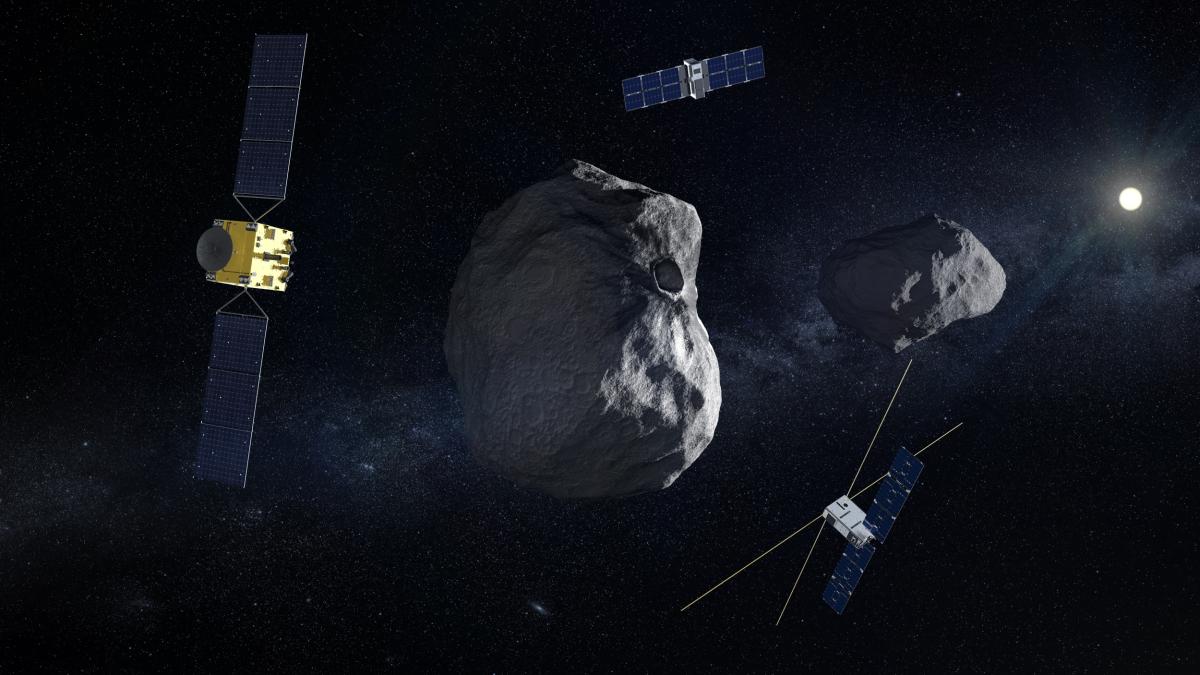On 7 October 2024, despite extremely difficult weather conditions, the HERA space probe was launched from the Cape Canaveral/Florida spaceport to the double asteroid Didymos and Dimorphos. NASA's DART space probe arrived there in 2022 to change its orbit. Hera has now been sent on its way to the double asteroid to investigate how exactly the orbital period and shape of the asteroids have changed. Scientists from the Museum für Naturkunde Berlin are also part of the international teams of experts on both missions and were present at the launch.
‘The execution of such a mission requires extensive modelling and simulation of the kinetic impact, which is being developed with the active support of the Museum für Naturkunde Berlin,’ says Prof. Dr. Kai Wünnemann, who is co-chair of the Impact Modelling working group and a member of the science team together with his colleague Dr. Robert Luther from the Museum für Naturkunde Berlin. Wünnemann is also head of the ‘Solar System, Impacts & Meteorites’ department at the Museum für Naturkunde Berlin, which specialises in the formation and collision history of our solar system, in particular the Earth-like planets and minor planets (asteroids).
The impact of cosmic bodies on Earth can have devastating consequences. 66 million years ago, an asteroid hit Mexico and was very likely the cause of the extinction of the dinosaurs. Most recently, in 2013, there was an unforeseen impact of a cosmic body 19 metres in diameter that exploded over the Russian city of Chelyabinsk. These events are very rare, but the danger posed by near-Earth objects in particular should not be underestimated. However, is it possible to deflect an asteroid in space so that it does not hit the earth in reality and not just in science fiction films? This and many other questions are now to be answered by the European Space Agency's (ESA) Hera mission. The German Space Agency at the German Aerospace Centre (DLR) is coordinating the German ESA contributions with funding from the Federal Ministry of Economics and Climate Protection (BMWK). Scientists from the Museum für Naturkunde Berlin are also part of the international teams of experts on both missions.
NASA made the start with the DART (Double Asteroid Redirection Test) space probe. The double asteroid Didymos and Dimorphos was chosen as the target, with the much smaller Dimorphos (diameter around 150 metres) orbiting the larger Didymos (diameter around 800 metres) as an asteroid moon. The aim was to influence the orbital period of both asteroids around each other. To this end, DART made a controlled impact with Dimorphos on 26 September 2022 at a speed of over six kilometres per second (22,500 kilometres per hour). Measurements with telescopes were able to determine that the orbital period of Dimorphos had shortened by 33 minutes from the original 11 hours 55 minutes - previously only 10 minutes had been modelled.
Hera has now been sent on a two-year journey to the double asteroid to investigate for six months how exactly the orbital period and shape of the asteroid have changed. Did a crater form on Dimorphos? Has the entire asteroid been altered? The aim of the analyses is to create a detailed map of the surface and inner structure of the moon using high-resolution visual, laser-based and radar data. It is crucial to analyse the impact crater created by the DART probe, as this allows important conclusions to be drawn about the asteroid's properties.
